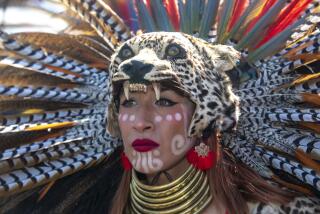The Outback Comes to L.A.
- Share via
It’s hard to faze an Angeleno.
But if you had been cruising down Olympic Boulevard in Santa Monica on a recent Friday, passing New Roads School, you might have wondered if you had driven into “Survivor II” in the outback.
There, on a round patch of grass, with Los Angeles traffic whizzing by in the background, a group of Aboriginal teens stripped off their surfer glasses and jeans, painted their bodies with stripes of blue, and danced with spears to the low, haunting sound of the didgeridoo.
The dancers flew like birds and stalked like hunters. They wiggled their knees and crept like warriors on the hunt. Then they made their California counterparts come up and dance with them.
The teens were from an isolated 17-mile-square Aboriginal community in northeast Queensland known as Yarrabah. They were here on a two-week trip designed to show them the world and give them an incentive to stay in school and avoid drugs and alcohol. In their community of 3,500, 50% of kids drop out before the end of 10th grade, and the nearest high school is an hour’s drive away on the other side of a mountain.
Though they had watched “Jerry Springer” and “The Sopranos” at home, before their journey to Los Angeles, none of the teenagers had ever been on a train or a plane, said the group’s leader and adult chaperon, Sharon Bonython-Ericson. Few had been outside of Queensland, let alone Australia.
To come to the United States the 11 Aborigines, ages 14 to 17, had to stay away from drugs and alcohol for a year, raise $2,000 each and undergo tutoring and counseling, Bonython-Ericson said.
The group originally planned to visit 11 schools during three weeks, but a shooting occurred at one of the schools, in Santee, where the students were supposed to stay. The trip was nearly canceled until one of the U.S. consuls in Australia intervened. An abbreviated visit was reinstated, with a week at the private New Roads School and a few days with some Native Americans in San Diego County.
*
New Roads’ students said their visitors were extremely shy, but they told a mixture of tall tales and real ones, indistinguishable to their American hosts. They told stories of battling or eating animals such as crocodiles, kangaroos (the tail is the best part--it’s soft), koalas and wallabies.
The students seemed overwhelmed by the speed and size of Los Angeles. They said little--perhaps it was culture shock or just being an adolescent.
Meagan Noble, 15, whose aboriginal name is Gindandji, meaning the moon, said she was surprised to see homeless people in a city with so many rich houses.
“The traffic is wild,” she said, peering out at the cars whizzing by. “And it’s cold.”
Paul Neal, 17, whose Aboriginal name is Giengarra, which means thorny tree, was surprised how similar things are.
“The kids are the same, like us. They listen to the same music,” he said. “What’s funny is how they love ‘Survivor.’ ”
More to Read
Sign up for The Wild
We’ll help you find the best places to hike, bike and run, as well as the perfect silent spots for meditation and yoga.
You may occasionally receive promotional content from the Los Angeles Times.






